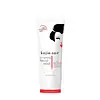What's inside
What's inside
 Key Ingredients
Key Ingredients

 Benefits
Benefits

 Concerns
Concerns

 Ingredients Side-by-side
Ingredients Side-by-side

Water
Skin ConditioningStearic Acid
CleansingLauric Acid
CleansingMyristic Acid
CleansingGlycerin
HumectantSodium Lauroamphoacetate
CleansingPotassium Hydroxide
BufferingGlycol Distearate
EmollientDecyl Glucoside
CleansingCoco-Glucoside
CleansingGlyceryl Oleate
EmollientLactobacillus Ferment
Skin ConditioningAvena Sativa Kernel Extract
AbrasiveSodium Benzoate
MaskingPotassium Sorbate
PreservativeSaccharide Isomerate
HumectantCitric Acid
BufferingSodium Citrate
BufferingAcrylates Copolymer
Cocamide Mea
EmulsifyingParfum
MaskingKojic Acid
AntioxidantPropanediol
SolventRhamnose
HumectantGlucose
HumectantGluconic Acid
Butylene Glycol
HumectantHydrolyzed Yeast Protein
Skin ConditioningFomes Officinalis Extract
Skin ProtectingPyridoxine
Skin ConditioningNiacinamide
SmoothingPanthenol
Skin ConditioningAllantoin
Skin ConditioningThreonine
Biotin
AntiseborrhoeicIodopropynyl Butylcarbamate
PreservativePhenoxyethanol
PreservativeMenthyl Lactate
MaskingPolyquaternium-7
EDTA
Water, Stearic Acid, Lauric Acid, Myristic Acid, Glycerin, Sodium Lauroamphoacetate, Potassium Hydroxide, Glycol Distearate, Decyl Glucoside, Coco-Glucoside, Glyceryl Oleate, Lactobacillus Ferment, Avena Sativa Kernel Extract, Sodium Benzoate, Potassium Sorbate, Saccharide Isomerate, Citric Acid, Sodium Citrate, Acrylates Copolymer, Cocamide Mea, Parfum, Kojic Acid, Propanediol, Rhamnose, Glucose, Gluconic Acid, Butylene Glycol, Hydrolyzed Yeast Protein, Fomes Officinalis Extract, Pyridoxine, Niacinamide, Panthenol, Allantoin, Threonine, Biotin, Iodopropynyl Butylcarbamate, Phenoxyethanol, Menthyl Lactate, Polyquaternium-7, EDTA
Cocos Nucifera Oil
MaskingWater
Skin ConditioningSodium Hydroxide
BufferingParfum
MaskingKojic Acid
AntioxidantGlycerin
HumectantXanthan Gum
EmulsifyingCaprylyl Glycol
EmollientGlucose
HumectantChondrus Crispus
MaskingPhenoxyethanol
PreservativeEthylhexylglycerin
Skin ConditioningCocamide DEA
EmulsifyingParaffinum Liquidum
EmollientMelaleuca Alternifolia Leaf Oil
AntioxidantCI 15985
Cosmetic ColorantCI 19140
Cosmetic ColorantBHT
Antioxidant
 Reviews
Reviews

Ingredients Explained
These ingredients are found in both products.
Ingredients higher up in an ingredient list are typically present in a larger amount.
Glucose is a simple sugar and is the most important source of energy in all organisms.
In skincare, glucose is used to hydrate the skin. It also acts as a prebiotic for our natural biome.
Glucose is hydrating due to its humectant property. As a humectant, glucose draws moisture from the air and from deeper levels in the skin.
Our skin contains many sugars that act as prebiotics and help strengthen our natural microbiome. Having a healthy microbiome helps protect our skin from harmful bacteria and other contaminants.
Studies show glucose may help with fading discoloration and pigmentation. This is because our skin metabolizes glucose into lactic acid. Lactic acid is an AHA that helps exfoliate the top layer of skin.
Learn more about GlucoseGlycerin is already naturally found in your skin. It helps moisturize and protect your skin.
A study from 2016 found glycerin to be more effective as a humectant than AHAs and hyaluronic acid.
As a humectant, it helps the skin stay hydrated by pulling moisture to your skin. The low molecular weight of glycerin allows it to pull moisture into the deeper layers of your skin.
Hydrated skin improves your skin barrier; Your skin barrier helps protect against irritants and bacteria.
Glycerin has also been found to have antimicrobial and antiviral properties. Due to these properties, glycerin is often used in wound and burn treatments.
In cosmetics, glycerin is usually derived from plants such as soybean or palm. However, it can also be sourced from animals, such as tallow or animal fat.
This ingredient is organic, colorless, odorless, and non-toxic.
Glycerin is the name for this ingredient in American English. British English uses Glycerol/Glycerine.
Learn more about GlycerinKojic acid comes from fungi and can also be from fermented foods. It helps even out skin tone and reduce hyperpigmentation.
This ingredient works by blocking tyrosine, an enzyme that starts the process of skin darkening.
Kojic Acid is antifungal and often used to treat fungal infections. Additionally, it can help fight bacteria with its antimicrobrial properties. This can help treat acne as well.
A similar ingredient is arbutin.
Learn more about Kojic AcidParfum is a catch-all term for an ingredient or more that is used to give a scent to products.
Also called "fragrance", this ingredient can be a blend of hundreds of chemicals or plant oils. This means every product with "fragrance" or "parfum" in the ingredients list is a different mixture.
For instance, Habanolide is a proprietary trade name for a specific aroma chemical. When used as a fragrance ingredient in cosmetics, most aroma chemicals fall under the broad labeling category of “FRAGRANCE” or “PARFUM” according to EU and US regulations.
The term 'parfum' or 'fragrance' is not regulated in many countries. In many cases, it is up to the brand to define this term.
For instance, many brands choose to label themselves as "fragrance-free" because they are not using synthetic fragrances. However, their products may still contain ingredients such as essential oils that are considered a fragrance by INCI standards.
One example is Calendula flower extract. Calendula is an essential oil that still imparts a scent or 'fragrance'.
Depending on the blend, the ingredients in the mixture can cause allergies and sensitivities on the skin. Some ingredients that are known EU allergens include linalool and citronellol.
Parfum can also be used to mask or cover an unpleasant scent.
The bottom line is: not all fragrances/parfum/ingredients are created equally. If you are worried about fragrances, we recommend taking a closer look at an ingredient. And of course, we always recommend speaking with a professional.
Learn more about ParfumPhenoxyethanol is a preservative that has germicide, antimicrobial, and aromatic properties. Studies show that phenoxyethanol can prevent microbial growth. By itself, it has a scent that is similar to that of a rose.
It's often used in formulations along with Caprylyl Glycol to preserve the shelf life of products.
Water. It's the most common cosmetic ingredient of all. You'll usually see it at the top of ingredient lists, meaning that it makes up the largest part of the product.
So why is it so popular? Water most often acts as a solvent - this means that it helps dissolve other ingredients into the formulation.
You'll also recognize water as that liquid we all need to stay alive. If you see this, drink a glass of water. Stay hydrated!
Learn more about Water